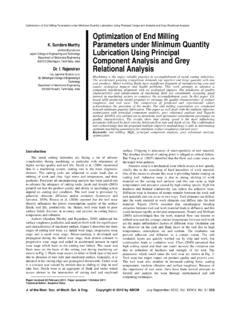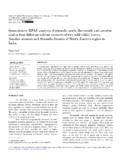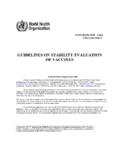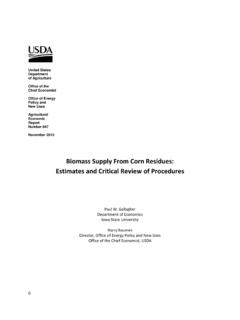Transcription of Horses in Europe - WBFSH
1 Horses in EuropeBy Carolina Liljenstolpe Photo: Roland Thunholm This report aims to provide an overall picture of the horse industry in Europe and its economic importance. The purpose is to describe different characteristics of the horse industry in the European countries and to illustrate both similarities and differences. The report consists of four sections discussing the economic role of the horse, the impacts of the CAP (EU Common Agricultural Policy) on the horse industry, the breeding industry as well as the role of the horse in the civil society. The information used for this report is based upon official statistics from Eurostat, FAOStat, UET, IFHA and FEI.
2 Moreover, as statistics of the horse sector is sometimes limited, questionnaires concerning the horse industry as a whole, the trotting as well as the thoroughbred racing industry have been sent to representatives of the countries in the European Union. The representatives were selected from the register of COPA-delegates, from the respective ministries of agriculture or from the local UET and IFHA organizations. It should however be noted that the results in this study are based on individual responses to questionnaires sometimes based on own approximations made by individuals involved in the industry.
3 Hence, the information provided here should to some extent be regarded more as an indication of how the status of the sector has changed and provide a general view of development trends. A general conclusion from this report is that statistics regarding the horse industry within the European countries is rather limited and much has to be done in this respect in order to provide an accurate picture of the industry. Hereby it should be stressed that future research into equine sciences also should include studies on information systems and international harmonization of data. Carolina Liljenstolpe, Agr Dr (author) Professor Hans Andersson (project coordinator) The project has been financed by the Swedish Horse Council Foundation, Swedish Board of Agriculture and SLU.
4 The editorial assistance of Dr Cecilia L nnell, DVM, is gratefully acknowledged 1 1 Introduction The horse industry in the European Union is of economic importance to all countries. The European Union today consist of 27 member states and the total number of Horses in the region is estimated to exceed 5 million. In the past Horses were vital in industry, agriculture, transport and the military. Horses today can represent a leisure or sporting activity, a way of life, a working companion or food. Horses in Europe represent a part of our common history. In different parts of Europe different breeds have evolved depending on environmental conditions and the intended use of the breed.
5 In modern time, the national borders between the European countries have become less important also in the horse world. At least on the surface we are homogenous as you can see the same type of horse activities and breeds represented all over the continent. However, while there are similarities there are also many differences, including favourite choice of horse sports, how the betting on Horses is organized and the degree of state involvement in the horse industry. Thus the horse industry of Europe is more varied than maybe expected at a first glance. Prior to the Equus 2001 meeting, a project was initiated by The Swedish Horse Council Foundation which resulted in the report The Horse Industry in the European Union.
6 This report was produced in cooperation between The Swedish Horse Council Foundation and the Department of Economics, The Swedish College of Agricultural Sciences (SLU). Now Sweden will host the EU Equus 2009 conference during autumn 2009, in connection with its EU Presidency. The aim of this report is to give an updated presentation of the horse industry in the European Union of today and to provide some information on how the sector has evolved during the last ten years. A major change since the Equus 2001 report was written is the new member countries of the European Union. In May 2004, eight Eastern European (EU-8) countries joined the European Union.
7 Among the new member states that have a considerable horse industry counts Hungary, Poland, Slovenia and Czech Republic. As the European Union has expanded, so has the total number of Horses . Germany and Great Britain have the largest horse populations in the European Union. However Sweden has the highest number of Horses per capita, and Belgium and the Netherlands the highest density of Horses per 1 000 ha land. The number of Horses per capita has remained relatively constant in Europe during the past decade. Even though the exact numbers of horse related enterprises are yet not available in National statistics, an impression from questionnaires for this report is that the diversity of horse related enterprises has increased over time.
8 In the future there will most likely be a trend towards further diversification into new markets in the horse industry. The business innovations and opportunities in terms of provided services and equipment for horse owners as well as for Horses seem vast. The economic importance of the horse is not expected to diminish in the future. 2 Table Total number of Horses in some European countries Member state Total number of Horses (2007) Population (2006)** Horses /1000 persons Horses /1000 ha Austria 100 000 8 265 925 Belgium 300 000 10 511 382 Czech Republic 64 126 10 188 000 Denmark 150 000* 5 427 459 Estonia 4 900* 1 339 000 Finland 77 000* 5 266 000 France 900 000 62 998 773 Germany 1 000 000 82 437 995 Great Britain 1 000 000 60 393 044 Greece 27 000* 11 122 000
9 Hungary 60 000* 10 058 000 Ireland 80 000* 4 221 000 Italy 300 000* 58 778 000 Latvia 13 600* 2 289 000 Luxembourg 4 490* 461 000 Netherlands 400 000 16 334 210 Norway 45 0001 4 668 000 Poland 320 000 38 157 055 Serbia 35 000* 2 003 358 Slovakia 8 000* 5 388 000 Slovenia 22 000* 2 000 000 Spain 559 598 43 886 000 Sweden 280 000 9 047 752 TOTAL 5 750 714 455 240 953 Source.
10 Own questionnaires ,* FAO (2009) and ** Eurostat (2009). Meanwhile the mobility of Horses between the European countries has also increased, both for sport, import/export and slaughter. Every year about 100 000 Horses for slaughter are transported over long distances within Europe2. In sport the International Equestrian Federation (FEI) organizes about 250 international competitions annually, which involve extensive sport horse transport within EU3. In Germany the horse movements due to competitions have been estimated to be over millions a year4. For food safety related issues with consumption of horse meat and to keep control of the movements of Horses and the number of Horses , a regulation of equine passport registration has been initiated.









